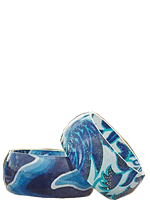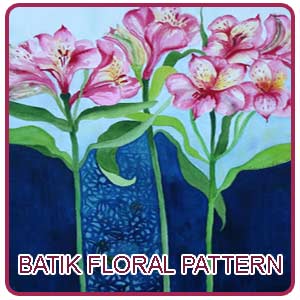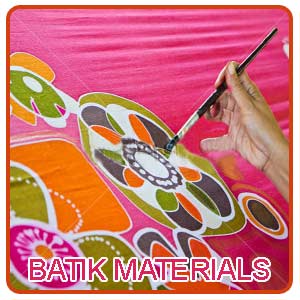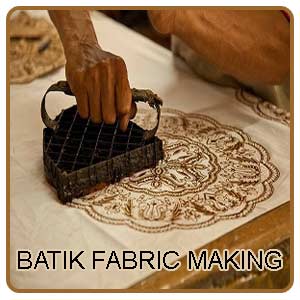 HISTORY OF BATIK FABRIC
HISTORY OF BATIK FABRIC
Batik is more of a traditionally made cloth whose origin is not precisely known. It dates back to nearly 1,500 years ago where the dye resistance pattern on cloths were said to be seen in Egypt and the Middle East. But however samples of Batik are also seen in other countries like Turkey, India, China, Japan and West Africa.
Indians learnt the method of resist printing on cotton fabrics much before the world tried it. Indian Batik is said to be around 2000 years old. . Religious tapestries of ancient India hold proof that Batik printing existed in India from quite a long time. India had abundant resources of cotton and dye-yielding plants that this technique flourished for long in the country. But this Batik printing was labour intensive and hence the art began to decline with the advent of modern technology. Batik Art has been introduced as a subject in the famous Shantiniketan University in Kolkata. Chola Mandal in Chennai is also known for its Batik printing and related products.
 THE TRADITIONAL COLOR INCLUDED IN THE BATIK MATERIAL
THE TRADITIONAL COLOR INCLUDED IN THE BATIK MATERIAL
-The most common and the traditional color included in the Batik material are indigo, dark brown, and white which also according to the people means the three major Hindu Gods Brahma, Vishnu, and Siva. Another fact which states why indigo and brown are mostly used in the dyeing is that they are the most commonly available natural dye. The design on the Batik also indicates the status of an individual like patterns with wider stripes or wavy lines of greater width usually signifies nobility of a person who is in a high social status. Consequently, during Javanese ceremonies, one could determine the royal lineage of a person by the cloth he or she was wearing. The Batik fabric is by itself an art form which is noted for its wax resisting dyeing technique.
 THE BATIK
THE BATIK
The word Batik has been derived from the Javanese words "Amba", meaning to write, and " titik", meaning dot or point. Batik is a process of decorating a cloth piece by covering a part of it with a wax coat and then dyeing the remaining part of the cloth. The waxed areas retain their original color while the un-waxed areas get the color of the dye. When the wax is removed the contrast between the dyed and undyed areas gives the pattern. One of the significant features of this art is that it is very simple and can be done easily.
Colorful batik prints would very much grace the home furnishings with elegance and style. Beautiful bags, household linens, murals and wall paintings with batik works have a great demand in the domestic and international market. Batik has also made its mark in impressive textile products. Batik printed kurtis, saris are in vogue these days among the modern populace.
 THE WAX, FABRIC AND DYES
THE WAX, FABRIC AND DYES Batik wax exercises an important function in the process of batik printing. Proper usage of wax results into an impeccable batik work. 30 per cent beeswax and 70 per cent paraffin wax are generally applied. During application the wax should not be overheated or it will catch fire and ruin the entire thing.
Cotton and pure silk are the best fabrics for Batik as these are strong enough to bear the heat and wax. The other common batik fabrics that make for excellent batik prints are cambric, poplin, voiles.
Natural colors derived from barks of trees, leaves, flowers and minerals were used. The weave of the cloth should not be too close, and the fabric should be translucent when held in front of a light.
The dyes used for Batik Printing are natural and derived from barks of trees, leaves, flowers and minerals which are native to our country. The indigo blue was one of the earliest dyes to be used. It was obtained from indigo, while orange and red were from henna. Yellow was from turmeric and lilac and mauve from logwood. Black was created by burning iron in molasses and cochineal from insects.
 THE BATIK TECHNIQUE
THE BATIK TECHNIQUE
The art of batik is a three-stage process of waxing, dyeing and de-waxing or removing of the wax. There are also several sub-processes involved like preparing the cloth, tracing the designs to be printed, stretching the cloth on the frame to make it stiff or tight , waxing the area of the cloth that does not need dyeing, preparing the dye, dipping the cloth in dye, boiling the cloth to remove wax and washing the cloth in soap.
 THE BATIK PROCESS
THE BATIK PROCESS
Fabrics are first washed thoroughly to get rid of the starch and other stains before the dyeing. The design is traced and then the fabric is stretched on a wood frame. The parts of the design to be white, for example must be waxed at the same time before any subsequent dyeing. Molten wax is either applied with thin brush or a special pen is used to achieve very fine lines. Wax is filled in the of the pen and it flows via the small hole in the spout to the cloth.
After the first waxing the fabric is dipped into a dye bath whose color is the lightest tone of those to be used. Only cold dyes are used, so wax remains intact on the design. When the piece has dried, there would be an area of white and an area of cloth that is the color of the first dyeing. Wax is now applied to those parts in which we wish to retain the first color, and the entire fabric is immersed in the second dye bath whose color is darker in tone than the first. This process is repeated until the darkest tone required in the final design is got.
 VARIOUS METHODS OF BATIK PRINTING
VARIOUS METHODS OF BATIK PRINTING
Splash method
Screen-printing method,
Hand painting which is by a Kalamkari pen
 COLORS INVOLVED
COLORS INVOLVED
-The Painter is not limited in any way in the variety of colors he uses. In case of batik, however, each color used is significantly changed by the proceeding color; or at least it is certainly affected by the color "underneath". The only pure color is the first one, so all other colors used are mixtures, determined largely by the first color, or the first strong color. Therefore, it is very important to have a complete understanding about color mixing. The colors in Batik are much more resistant to wear than those of painted or printed fabrics because the cloth is completely immersed in dye and the areas not protected by resist are allowed to absorb hues to the extent that the colors do not easily fade.
 THE FINAL PROCESS
THE FINAL PROCESS
-After the final dying, the fabric is boiled in water to remove the wax. Then it is washed with soap and water. When the fabric has dried it is placed between sheets of absorbent paper and a hot iron applied, to completely melt away any remaining wax. As the sheets of paper absorb the wax they are replaced by fresh sheets until the wax is completely removed. At this point the final design is seen clearly for the first time. Because of the tedious process of dyeing and waxing this art is declining and giving way to machine printed textiles.
 BATIK INDUSTRY FACES HIGH PRODUCTION COSTS
BATIK INDUSTRY FACES HIGH PRODUCTION COSTS
-Since the industries are not well equipped the industrial waste is causing river/ water source pollution. The Batik industry faces high production costs as well as, due to fall in batik sales, cause of recession, Batik industry workers face the possibility of losing their jobs. A genuine batik fabric can be distinguished from a print where the original fabric will look the same on both the sides and often has crinkled fine lines throughout whereas a printed one will have a good side and a bad side.
 DEALERS OF BATIK FABRIC
DEALERS OF BATIK FABRIC
| 1. J. C Overseas Inc., No. 32, Arjun Puri, Imali Phatak, Near Parshuram Secondary School, Sahkar Marg, Jaipur - 302015, Rajasthan, India. Phone: 08376807883
|
| 2. Bherugarh Cluster Club, 76, Main Road, Bherugarh , Ujjain - 456001, Madhya Pradesh, India. Phone: 08588873568
|
| 3. Dhingra Fabrics Pvt. Ltd., No. X-1/ 3815, Gali No. 11, Shanti Mohalla, Gandhi Nagar , Delhi - 110031, India. Phone: 08588803212
|
| 4. Mitras, No. 125/ G, Bidhan Park, Noapara , Kolkata - 700 090, West Bengal, India. Phone: 09953362014
|
| 5. Shree Salasar Synthetics, A - 2019 - 2020, New Textile Market, Ring Road, Surat - 395 002, Gujarat, India. Phone: 08587909872
|
 HISTORY OF BATIK FABRIC
HISTORY OF BATIK FABRIC  THE TRADITIONAL COLOR INCLUDED IN THE BATIK MATERIAL
THE TRADITIONAL COLOR INCLUDED IN THE BATIK MATERIAL THE BATIK
THE BATIK 
 THE WAX, FABRIC AND DYES
THE WAX, FABRIC AND DYES
 THE BATIK TECHNIQUE
THE BATIK TECHNIQUE THE BATIK PROCESS
THE BATIK PROCESS
 VARIOUS METHODS OF BATIK PRINTING
VARIOUS METHODS OF BATIK PRINTING COLORS INVOLVED
COLORS INVOLVED THE FINAL PROCESS
THE FINAL PROCESS BATIK INDUSTRY FACES HIGH PRODUCTION COSTS
BATIK INDUSTRY FACES HIGH PRODUCTION COSTS DEALERS OF BATIK FABRIC
DEALERS OF BATIK FABRIC


